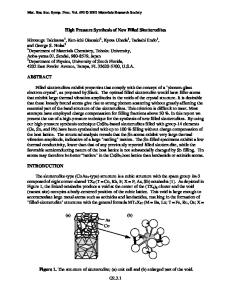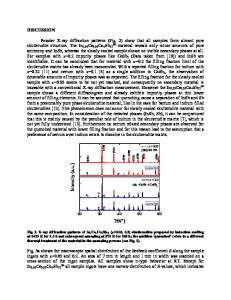Fabrication of nanostructured bulk Cobalt Antimonide (CoSb 3 ) based skutterudites via bottom-up synthesis
- PDF / 1,027,726 Bytes
- 6 Pages / 432 x 648 pts Page_size
- 24 Downloads / 312 Views
Fabrication of nanostructured bulk Cobalt Antimonide (CoSb3) based skutterudites via bottom-up synthesis M. Saleemi*,1, M. Y. Tafti1, M. S. Toprak1, M. Stingaciu2, M. Johnsson2, M. Jägle3, A. Jacquot3, M. Muhammed1 1 Department of Materials and Nanophysics, KTH Royal Institute of Technology, KistaStockholm, Sweden. 2 Department of Materials and Environmental Chemistry, Stockholm University, Stockholm, Sweden. 3 Fraunhofer-Institut für Physikalische Messtechnik IPM, 79110 Freiburg, Germany Keywords: Bottom up synthesis, Thermoelectric, Nanostructured, Skutterudite, Cobalt Antimonide, Spark Plasma Sintering. ABSTRACT Skutterudites are known to be efficient thermoelectric (TE) materials in the temperature range from 600 K to 900 K. Dimensionless figure of merit (ZT) for filled skutterudite TE materials have been reported as ca. 1 at 800 K. Novel nano- engineering approaches and filling of the skutterudites crystal can further improve the transport properties and ultimately the ZT. Although classified among the promising TE materials, research on their large-scale production via bottom up synthetic routes is rather limited. In this work, large quantity of cobalt antimonide (CoSb3) based skutterudites nanopowder (NP) was fabricated through a room temperature coprecipitation precursor method. Dried precipitates were process by thermo-chemical treatment steps including calcination (in air) and reduction (in hydrogen). CoSb3 NPs were then mixed with silver (Ag) nanoparticles at different weight percentages (1%, 5% and 10% by wt) to form nanocomposites. Skutterudite NP was then consolidated by Spark Plasma Sintering (SPS) technique to produce highly dense compacts while maintaining the nanostructure. Temperature dependent TE characteristics of SPS’d CoSb3 and Ag containing nanocomposite samples were evaluated for transport properties, including thermal conductivity, electrical conductivity and Seebeck coefficient over the temperature range of 300 - 900 K. Physicochemical, structural and microstructural evaluation results are presented in detail. INTRODUCTION Skutterudites have been widely investigated as potential next generation thermoelectric (TE) materials for energy harvesting. Due to their unique crystal structure and exclusive electrical transport properties, they are known to be one of the promising TE material in the temperature range of 600 to 900 K.[1] Bulk productions of skutterudite based TE materials with high purity and homogeneity is major obstacle to commercialize the skutterudite TE modules. Furthermore, relatively high thermal conductivity causes the poor TE performance in such materials. Cobalt anitmonide (CoSb3) based skutterudites have attained great attention because of their low volatility, abundancy of the elements involved and lower production cost than other classes of skutterudites.[2-3] CoSb3 is a narrow band semiconductor material with excellent electrical transport properties among skutterudites. CoSb3 represents cubic crystal and belongs to
121
space group IM3. In this structure, cobalt (Co)
Data Loading...










